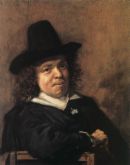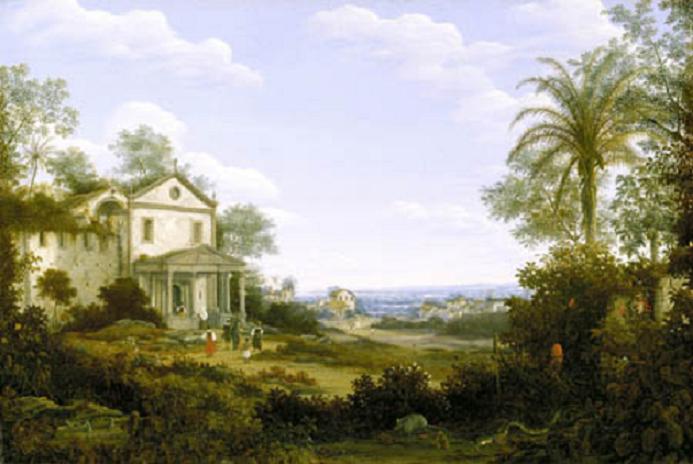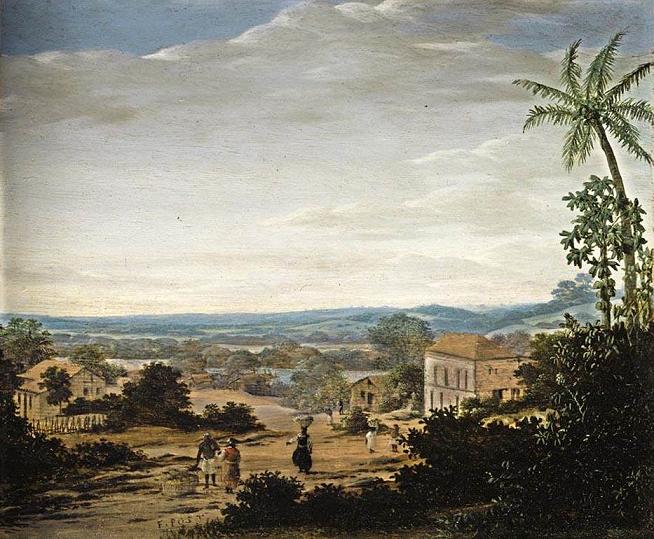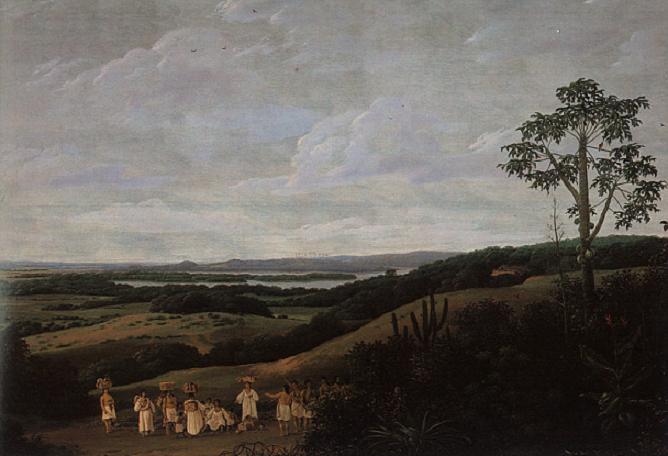Frans Janszoon Post (1612—1680)
Frans Hals - Portrait of the painter Frans Post
(Worcester Art Museum, USA)
Frans Janszoon Post (1612—1680)
was a Dutch painter. He was the first European artist to paint
landscapes of America. In 1636 he traveled to Dutch Brazil at the
invitation of Johan Maurits van Nassau-Siegen.
Biography
Post was born
in Haarlem and was the son of Jan Janszoon Post (who was a highly
regarded glass painter trained in Leiden), and Francijntje Verbraken of
Haarlem. His older brother was Pieter Post, one of the most important
architects of Dutch classicism. Little is known of his life before his
trip to Brazil.
He was born in
Haarlem, circa 1612 and he most likely received his early training from
his father and his older brother. He was a contemporary of Frans Hals,
who painted his portrait, and prominent Haarlem landscape painters such
as the brothers Jacob & Salomon van Ruysdael, Adriaen & Isaac
van Ostade, and in particular Pieter de Molijn. It is likely that a
Dutch master also taught him before he left for Brazil, though he was
not registered in the guild until after his return. Although not
universally accepted, Post scholar Erik Larsen believes De Molijn was
the master under whom Post studied, because Molyn is mentioned in
Houbraken as the teacher of several other landscape painters, such as
Allart van Everdingen.
Post won a
commission at court through the connections of his older brother and was
encouraged to travel abroad by John Maurice, Prince of Nassau-Siegen.
Post lived in Brazil from 1637-1644. He received 800 guilders for a
landscape painting in the West Indies commissioned by Frederick Henry,
Prince of Orange, leading Larsen to believe that Post set out for The
Netherlands via Africa shortly before Nassau departed Brazil. After he
returned to The Netherlands, he joined the Haarlem Guild of St. Luke in
1646, and was appointed officer in 1656-7 and 1658. In 1650, he married
Jannetje Bogaert, the daughter of Professor Salomon Bogaert of the
Haarlem ‘Latijnsche School’. He had two sons, who died before his death
and one daughter that did survive him, but died shortly thereafter.
Post continued
to paint Brazilian scenes until 1669, and the lack of dated paintings in
the 1670s suggests he stopped ten years before his death. Whitehead and
Boeseman claim that Post developed an alcohol problem, which may be the
reason so little is known of the last decade of his life. He died in
Haarlem and was buried in the St. Bavochurch on February 17, 1680.
Work
Post produced
approximately 140 paintings during his lifetime. Of these, nearly half
are dated, making it possible to track the evolution of his work between
1637, the day he landed in Brazil, and 1669, the date of his last
letter. The paintings Post produced while he was in Brazil drastically
differ from those he painted after he left Brazil. While he was in
Brazil, he produced a large number of sketches and etchings, but only
completed six paintings. They are the paintings dated from 1637–1640,
and later presented by Nassau to Louis XIV in 1679.
His Brazilian works strongly resemble the landscapes by his Haarlem contemporaries in terms of composition, style, and technique. Wolfgang Stechow describes Post’s landscapes as ‘the old bottle filled with new wine’. These works depict specific locations in Dutch Brazil, identifiable because of the representation of recognizable topography and buildings; most also include water. Post includes a selection of Brazilian vegetation, and occasionally features birds and other small animals in the foreground. The skies are a curious gray, seemingly heavy with rain, an aspect that is emphasized by the fact that they take up at least half the canvas. The subdued color scheme, especially when compared to his post-Brazilian production, lends them a somber almost reverential quality characteristic of Dutch tonal landscapes from the 1620s to the 1640s.
His Brazilian works strongly resemble the landscapes by his Haarlem contemporaries in terms of composition, style, and technique. Wolfgang Stechow describes Post’s landscapes as ‘the old bottle filled with new wine’. These works depict specific locations in Dutch Brazil, identifiable because of the representation of recognizable topography and buildings; most also include water. Post includes a selection of Brazilian vegetation, and occasionally features birds and other small animals in the foreground. The skies are a curious gray, seemingly heavy with rain, an aspect that is emphasized by the fact that they take up at least half the canvas. The subdued color scheme, especially when compared to his post-Brazilian production, lends them a somber almost reverential quality characteristic of Dutch tonal landscapes from the 1620s to the 1640s.
Brazilian landscapes from Haarlem
Post continued
to paint images of Brazil upon his return to The Netherlands in 1642;
however, his work undergoes a radical transformation. In addition to
Post’s wonderful imagination, the evolution of his work may also be
consequent of a change in popular style. The further he was from Brazil,
in both time and space, the more imaginary his paintings became as he
incorporated bright colors and exotic elements. Those paintings executed
in The Netherlands have brighter colors with dark foliage framing an
idealized baroque composition. These works are in striking contrast to
the stark, realistic qualities of his early work. The landscapes are
open, full of resources, and most important, conquered. They evolve to
show a more condensed view and desired depth with greener flora, bluer
skies, and brighter horizons. However, the horizontal blues advancing
towards the middle distance accentuate the difference in color. This
deep blue may be a disintegration of the green pigment, which results
from the disappearance of yellows, while the blues remain.
Upon Post’s return to The Netherlands, he also increased the number of figures and incorporated greater diversity into his work. Nearly every painting he completed in The Netherlands includes a large group of people interacting in some way, whether they are dancing or working in the sugar mills. Unlike his Brazilian work, the figures are no longer subjects placed in the foreground; instead, they seem to become part of the landscape. Four of the six paintings completed in Brazil only have a few figures, with the exception of Porto Calvo (1639) depicting more, and The River of São Francisco (1638), which does not have any figures. While Post was in charge of documenting the land, Albert Eckhout, another one of Nassau’s artists, was in charge of documenting the native people.
Upon Post’s return to The Netherlands, he also increased the number of figures and incorporated greater diversity into his work. Nearly every painting he completed in The Netherlands includes a large group of people interacting in some way, whether they are dancing or working in the sugar mills. Unlike his Brazilian work, the figures are no longer subjects placed in the foreground; instead, they seem to become part of the landscape. Four of the six paintings completed in Brazil only have a few figures, with the exception of Porto Calvo (1639) depicting more, and The River of São Francisco (1638), which does not have any figures. While Post was in charge of documenting the land, Albert Eckhout, another one of Nassau’s artists, was in charge of documenting the native people.
fonte:http://en.wikipedia.org/wiki/Frans_Post

Paisagem nos arredores de Porto Calvo, com uma figueira em primeiro plano em 1639.
VIDA
Pintor holandês, Frans Post
nasceu em Haarlem em 1612 e morreu na mesma cidade em 1680. Veio para o
Brasil com Maurício de Nassau em 1637, aqui permanecendo até 1644, quando
voltou para sua cidade natal.
PROJEÇÃO
Frans Post notabiliza-se
pela série de paisagens brasileiras que pinta ou desenha durante sua
permanência no Brasil e de volta a seu país.
Pouco depois de desembarcar
em Pernambuco pinta a primeira de suas telas sobre motivos brasileiros: "A
Ilha de Itamaracá" (1637; Mauritshuis, Haia). Ao tempo de sua formação, em
Haarlem, predominavam os paisagistas, sendo natural, assim, a predileção
do pintor por esse gênero. Frans Post reage à exuberância tropical com
grande contenção: não joga na tela a explosão de cores com que é
defrontado, preferindo registrar espaços abertos, salpicados de
miniaturas, em tons fortes mas não variados. Procura fixar as cenas mais
em razão de sua utilidade informativa, atento à composição e, como detalhe
típico, quase sempre colocando uma árvore numa das extremidades do
quadro.
O pitoresco ou inusitado
não o atrai: as cenas possuem um ar de tranqüilidade que é um de seus
encantos. Com o decorrer do tempo torna ainda mais sintéticas as suas
telas, onde às vezes busca fixar cenas em poucas pinceladas num espaço
diminuto.
O ponto alto de sua arte é
o famoso quadro "Panorama brasileiro" (1652; Rijksmuseum, Amsterdam): de
dimensões incomuns, apresenta a parte superior arrendondada, julgando-se
que fosse um dos painéis que adornavam a Huis Ryksdorp, em Wassenaar. A
paisagem, de 282,5 x 210,5cm, a óleo, tem predominância de tons verdes e
mostra um rio ziguezagueando, em meio de farta vegetação, contra a linha
baixa do horizonte onde se delineia o mar azul. O céu ocupa dois terços do
espaço, que é completado por frutas tropicais, numa composição de grande
harmonia.
OBRAS
Não é vasta a obra de Frans
Post, calculando-se que tenha executado entre duzentos e trezentos
trabalhos ao longo de quarenta anos. Além das paisagens brasileiras, que
formam a quase totalidade dessa obra, também são de sua autoria algumas
naturezas mortas - geralmente com frutos e flores do Brasil -, paisagens
holandesas e 32 desenhos de locais brasileiros e africanos reunidos no
álbum Archetypae Delineationes Brasiliae regionun ( Delineações
arquetípicas das regiões brasileiras: British Museum, Londres.).
O Museu Nacional de
Belas-Artes, no Rio de Janeiro, possui uma sala especial denominada "Frans
Post e a Pintura Flamengo-Holandesa do Séc. XVII", com um retrato de
Nassau, cinco paisagens de Pernambuco, uma paisagem de Olinda e outra da
Paraíba, todos de Post.
A Fundação Castro Maia, no
Rio de Janeiro, possui a tela "Engenho de Açucar", e o Museu de Arte de
São Paulo "A Cachoeira de Paulo Afonso", "Paisagem pernambucana com rio",
"Paisagem de Pernambuco com casa-grande" e "Paisagem com tamanduá".
No Museu do Louvre, em
Paris, estão "O Rio São Francisco e o forte Maurício", "O Carro de bois",
"Paisagem de Porto Calvo", "Forte dos reis Magos", "Moínho de açúcar",
"Casa de um nobre português", "Capela dos portugueses" e "Habitações
de plantadores perto o rio Paraíba".
Além da "Paisagem
brasileira", o Rijkmuseum de Amsterdam possui o quadro "Vilas nas
vizinhanças de Pernambuco"; no Museu do Estado, Copenhague: "A Fabricação
do acúcar"; Instituto de Artes, Detroit, E.U.A.: "Igreja jesuíta em
ruínas"; Universidade Católica da América, Washington, D.C.: "Paisagem com
um cortejo de negros"; Palácio Kensington, Londres: "Vila de indígenas";
Associação dos Colecionadores de Arte, Londres: "Paisagem
brasileira".
No Brasil ainda existem
quadros de Frans Post em São Paulo: na Biblioteca Municipal a "Vila perto
de Pernambuco"; em Pernambuco: no palácio do governo, "Paisagem
brasileira" (dois quadros); e Rio de Janeiro: no Palácio Guanabara,
"Índios Caçando" e "Paisagem de Pernambuco"; no Instituto Histórico e
Geográfico Brasileiro, "Ruínas de Olinda"; na embaixada do Reino Unido,
"Moínho de açúcar" e "Paisagem brasileira".


 | |
|
|
1652 -
Hacienda, Mittelrheinisches Landesmuseum,
Mainz
|
1665 - View of the Jesuit Church at
Olinda, Brazil - Institute of Arts,
Detroit
|
1670-75 -
A Brazilian Landscape, Private
Colection
|
1638 -
The Ox Cart, Musée du Louvre,
Paris
|
Brazilian
Landscape, Metropolitan Museum of Art, New
York
|

.jpg)









Nenhum comentário:
Postar um comentário